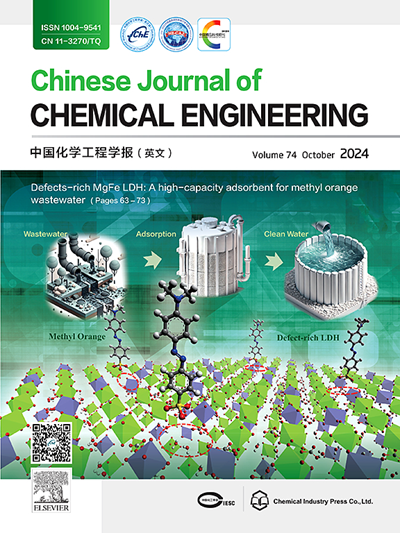Enhancing biomethane production from corn stover via anaerobic digestion incorporated with microbial electrolysis cell
IF 3.7
3区 工程技术
Q2 ENGINEERING, CHEMICAL
引用次数: 0
Abstract
Bioelectrochemical regulation has been proved to enhance the traditional anaerobic digestion (AD) of organic wastes. However, few investigations have explored whether it is possible to enhance the production of biomethane from raw corn stover (CS). A single-chamber microbial electrolysis cell (MEC) was incorporated with an AD to form a new system (MEC-AD) with aiming at more efficient bioconversion of CS to biomethane. The performance and microbiological characteristics of MEC-AD was investigated, and compared with conventional AD, which were inoculated with original inoculum (UAD) and electrically domesticated inoculum (EAD), respectively. The results showed that MEC-AD achieved the highest CH4 yield of 239.13 ml·g−1 VS, which was 29.28% and 12.44% higher than those of UAD and EAD, respectively. MEC-AD also achieved higher substance conversion rates of 73.24% VS, 91.16% cellulose, and 77.24% hemicellulose, respectively. The community characteristics of microorganisms revealed that the relative abundance and interactions of functional microorganisms in MEC-AD were obviously different from UAD and EAD. In MEC-AD, Electroactive bacteria (Sedimentibacter) with electrotrophic methanogens (Methanosarcina and Methanosaeta) in anodic biofilms established electrotrophic methanogenesis through direct interspecies electron transfer (DIET). The process of methanotrophic methanogenesis was facilitated by the interactions between fermentative acid-producing bacteria (FABs), syntrophic organic acid oxidation bacteria (SOBs), and methylotrophic methanogens (Methyl-HMs) in MEC-AD suspensions. Efficient synergistic interactions between these functional microorganisms improved the performance of MEC-AD in converting CS to produce biomethane. The study could provide an effective means for achieving higher AD biomethane production from raw CS.

结合微生物电解池厌氧消化提高玉米秸秆生物甲烷产量
生物电化学调节已被证明可以提高有机废物的传统厌氧消化(AD)。然而,很少有研究探讨是否有可能提高生玉米秸秆(CS)的生物甲烷产量。将单室微生物电解池(MEC)与AD组合成一个新的系统(MEC-AD),旨在更有效地将CS转化为生物甲烷。研究了MEC-AD的性能和微生物学特性,并与分别接种原始接种物(UAD)和电驯化接种物(EAD)的传统AD进行了比较。结果表明,MEC-AD的CH4产率最高,为239.13 ml·g−1 VS,比UAD和EAD分别提高29.28%和12.44%。MEC-AD也获得了更高的物质转化率,VS、纤维素和半纤维素分别达到73.24%、91.16%和77.24%。微生物群落特征显示,MEC-AD中功能微生物的相对丰度和相互作用明显不同于UAD和EAD。在MEC-AD中,电活性细菌(Sedimentibacter)与电养产甲烷菌(Methanosarcina和Methanosaeta)在阳极生物膜中通过直接种间电子转移(DIET)建立了电养产甲烷。MEC-AD悬浮液中发酵产酸菌(FABs)、合养有机酸氧化菌(SOBs)和甲基化产甲烷菌(Methyl-HMs)的相互作用促进了甲烷营养产甲烷过程。这些功能微生物之间有效的协同作用提高了MEC-AD将CS转化为生物甲烷的性能。该研究可为利用生CS提高AD生物甲烷产量提供有效手段。
本文章由计算机程序翻译,如有差异,请以英文原文为准。
求助全文
约1分钟内获得全文
求助全文
来源期刊

Chinese Journal of Chemical Engineering
工程技术-工程:化工
CiteScore
6.60
自引率
5.30%
发文量
4309
审稿时长
31 days
期刊介绍:
The Chinese Journal of Chemical Engineering (Monthly, started in 1982) is the official journal of the Chemical Industry and Engineering Society of China and published by the Chemical Industry Press Co. Ltd. The aim of the journal is to develop the international exchange of scientific and technical information in the field of chemical engineering. It publishes original research papers that cover the major advancements and achievements in chemical engineering in China as well as some articles from overseas contributors.
The topics of journal include chemical engineering, chemical technology, biochemical engineering, energy and environmental engineering and other relevant fields. Papers are published on the basis of their relevance to theoretical research, practical application or potential uses in the industry as Research Papers, Communications, Reviews and Perspectives. Prominent domestic and overseas chemical experts and scholars have been invited to form an International Advisory Board and the Editorial Committee. It enjoys recognition among Chinese academia and industry as a reliable source of information of what is going on in chemical engineering research, both domestic and abroad.
 求助内容:
求助内容: 应助结果提醒方式:
应助结果提醒方式:


